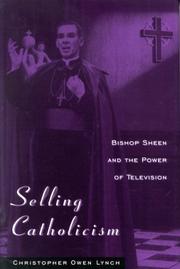| Listing 1 - 5 of 5 |
Sort by
|
Book
ISBN: 128199071X 9786611990718 3110210983 9783110210989 9783110205558 3110205556 Year: 2008 Publisher: Berlin ; New York : Walter de Gruyter,
Abstract | Keywords | Export | Availability | Bookmark
 Loading...
Loading...Choose an application
- Reference Manager
- EndNote
- RefWorks (Direct export to RefWorks)
Virtuelle Realitäten sind computervermittelte Kommunikationsräume. Man findet sie z. B. in Bildung, Kunst, Technik, Medizin und auch in der Religion. Der Band enthält in einem ersten Teil Beiträge zu einem praktisch-theologischen Verständnis des Phänomens. Dabei wird gefragt, wie wirklich die Wirklichkeit ist, inwiefern Anonymität zu Kommunikation gehört, welche Bedeutung der Humor für kommunikative Freiheit hat. Es werden Aspekte zu einem veränderten praktisch-theologischen Verständnis von Raum, Zeit und Geschichte vorgelegt. Christliche Religion wird als kulturelles Zeichensystem verständlich. Glaube zeigt sich als immersive Erfahrung der Anwesenheit Gottes. In einem zweiten Teil werden Erträge für die Sonntagsfrage und den Kirchenraum, die Kasualpraxis, die Gottesdienstlehre sowie insbesondere die Homiletik gehoben. Es zeigt sich, wie nah Medien und Religion bzw. Glaube miteinander verwandt sind, wenn es um die Wahrnehmung von Wirklichkeit geht. Christliche Religion und christlicher Glaube pflegen einen konstruktiven Umgang mit der Wirklichkeit.
Virtual reality --- Mass media --- Religious aspects --- Christianity. --- 251*23 --- Environments, Virtual --- Virtual environments --- Virtual worlds --- Computer simulation --- Reality --- Mass communication --- Media, Mass --- Media, The --- Communication --- 251*23 Verkondiging en moderne media: radio; TV; pers --- Verkondiging en moderne media: radio; TV; pers --- Religious aspects&delete& --- Christianity --- Communication Space. --- Homiletics. --- Liturgy. --- Virtuality.
Book
ISBN: 9033441101 Year: 1998 Volume: 44 Publisher: Leuven Acco
Abstract | Keywords | Export | Availability | Bookmark
 Loading...
Loading...Choose an application
- Reference Manager
- EndNote
- RefWorks (Direct export to RefWorks)
Computer assisted instruction --- Mass communications --- Didactics of religion --- Godsdienstige opvoeding --- Catechese --- Media --- Televisie --- Internet --- Muziek --- Video --- Audiovisuele media --- Websites --- Mass media --- Mass media in religion --- 433.2 ) Morele en religieuze opvoeding --- mediacultuur en godsdienstige vorming --- media in het godsdienstonderwijs --- 456.8 --- Cyberspace --- Didactiek --- Godsdienst --- Kerk --- Mediacultuur --- Popmuziek --- Theologie --- 244.5 --- Godsdienst; s.o --- Computeronderwijs: godsdienst --- godsdienst en media --- Kerk: media --- 230.3 --- catechese --- christendom --- godsdienst --- internet --- maatschappij --- media --- onderwijs --- Academic collection --- #gsdb6 --- 251*23 --- 371.694 --- 372.82 --- 251*23 Verkondiging en moderne media: radio; TV; pers --- Verkondiging en moderne media: radio; TV; pers --- Communication --- 372.82 Godsdienstonderwijs op school --- Godsdienstonderwijs op school --- Mass communication --- Media, Mass --- Media, The --- 371.694 Geprogrammeerde instructie. CAI. Leermachines. Computerbegeleid onderwijs. --- Geprogrammeerde instructie. CAI. Leermachines. Computerbegeleid onderwijs. --- Vormingsgebieden --- "(zie ook: wiskunde (didactiek; s.o.))" --- christendom en cultuur/maatschappij --- Geprogrammeerde instructie. CAI. Leermachines. Computerbegeleid onderwijs --- Religious aspects --- Geloofsopvoeding --- Website --- Afrika --- Compositie (muziek) --- Onderzoek --- Geweld --- Godsdiensten

ISBN: 9027225559 1556190069 9786613092953 1283092956 9027286299 9789027286291 9781556190063 9789027225559 Year: 1986 Volume: vol 5 Publisher: Amsterdam ; Philadelphia : J. Benjamins Pub. Co.,
Abstract | Keywords | Export | Availability | Bookmark
 Loading...
Loading...Choose an application
- Reference Manager
- EndNote
- RefWorks (Direct export to RefWorks)
The research reported in this volume attempts to refine our understanding of persuasive messages of television advertising by studying the role of language in persuasion in two ways. First, it comprises an attempt to refine our understanding of how language might function in persuasion by examining relevant work from a variety of related disciplines, potentially germane either in terms of their theoretical approaches to the process or in terms of the actual linguistic techniques which they have suggested as enhancing the persuasive impact of a message. Second, a comparative study was undertake
Lexicology. Semantics --- Pragmatics --- Evangelistic work -- Language. --- Persuasion (Rhetoric). --- Television advertising -- Language. --- Television in religion. --- Persuasion (Rhetoric) --- Television advertising --- Television in religion --- Evangelistic work --- Languages & Literatures --- Philology & Linguistics --- Language --- 654.197 --- 659.1 --- 251*23 --- #SBIB:309H2821 --- #SBIB:309H516 --- #SBIB:309H1524 --- Facsimile and television broadcasting --- Publicity. Advertising --- Verkondiging en moderne media: radio; TV; pers --- Reclameboodschap: functies, genres, taalgebruik historiek --- Verbale communicatie: retoriek --- Radio- en/of televisieprogramma’s met een persuasieve functie --- 251*23 Verkondiging en moderne media: radio; TV; pers --- 659.1 Publicity. Advertising --- 654.197 Facsimile and television broadcasting --- Language. --- Advertising, Television --- Television in advertising --- Evangelism --- Proselytizing --- Revival (Religion) --- Religious television --- Televangelism --- Television, Religious --- Christianity --- Forensics (Public speaking) --- Oratory --- Rhetoric --- Advertising --- Broadcast advertising --- Television broadcasting --- Television commercials --- Theology, Practical --- Discipling (Christianity) --- Religious awakening --- Religious broadcasting --- Religious aspects --- Reclame door televisie. Taal. --- Massacommunicatie / en evangelisatie. --- Televisie / en evangelisatie. --- Persuasion. --- Publicité par télévision. Langage. --- Diffusion collective (Techniques de) / et évangélisation. --- Télévision / et évangélisation. --- Overreding. --- Psycholinguistique --- Television et religion

ISBN: 0813157099 081317063X 9780813170633 0813120675 0813189462 9780813189468 9780813157092 Year: 1998 Publisher: Lexington, Kentucky : The University Press of Kentucky,
Abstract | Keywords | Export | Availability | Bookmark
 Loading...
Loading...Choose an application
- Reference Manager
- EndNote
- RefWorks (Direct export to RefWorks)
When the popularity of Milton Berle's television show began to slip, Berle quipped, ""At least I'm losing my ratings to God!"" He was referring to the popularity of ""Life Is Worth Living"" and its host, Bishop Fulton J. Sheen. The show aired from 1952 to 1957, and Sheen won an Emmy, beating competition that included Lucille Ball, Jimmy Durante, and Edward R. Murrow.What was the secret to Sheen's on-air success? Christopher Lynch examines how he reached a diverse audience by using television to synthesize traditional American Protestantism with a reassuring vision of Catholicism as patriotic a
Christianity and culture --- Television in religion --- Religious television --- Televangelism --- Television, Religious --- Religious broadcasting --- Television broadcasting --- Contextualization (Christian theology) --- Culture and Christianity --- Inculturation (Christian theology) --- Indigenization (Christian theology) --- Culture --- History --- History. --- Religious aspects --- Sheen, Fulton J. --- Sheen, Fulton John, --- Sheen, Peter John, --- Catholic Church --- Life is worth living (Television program) --- 251*23 --- 929 SHEEN, FULTON --- 929 SHEEN, FULTON Biografie. Genealogie. Heraldiek--SHEEN, FULTON --- Biografie. Genealogie. Heraldiek--SHEEN, FULTON --- Verkondiging en moderne media: radio; TV; pers --- 251*23 Verkondiging en moderne media: radio; TV; pers --- Church of Rome --- Roman Catholic Church --- Katholische Kirche --- Katolyt︠s︡ʹka t︠s︡erkva --- Römisch-Katholische Kirche --- Römische Kirche --- Ecclesia Catholica --- Eglise catholique --- Eglise catholique-romaine --- Katolicheskai︠a︡ t︠s︡erkovʹ --- Chiesa cattolica --- Iglesia Católica --- Kościół Katolicki --- Katolicki Kościół --- Kościół Rzymskokatolicki --- Nihon Katorikku Kyōkai --- Katholikē Ekklēsia --- Gereja Katolik --- Kenesiyah ha-Ḳatolit --- Kanisa Katoliki --- כנסיה הקתולית --- כנסייה הקתולית --- 가톨릭교 --- 천주교
Book
ISBN: 0814773095 0814790747 9780814773093 9780814790748 9780814773086 0814773087 9780814773109 0814773109 Year: 2011 Publisher: New York : New York University Press,
Abstract | Keywords | Export | Availability | Bookmark
 Loading...
Loading...Choose an application
- Reference Manager
- EndNote
- RefWorks (Direct export to RefWorks)
In the 1990's, Marilyn Agee developed one of the most well-known amateur evangelical websites focused on the “End Times”, The Bible Prophecy Corner. Around the same time, Lambert Dolphin, a retired Stanford physicist, started the website Lambert’s Library to discuss with others online how to experience the divine. While Marilyn and Lambert did not initially correspond directly, they have shared several correspondents in common. Even as early as 1999 it was clear that they were members of the same online network of Christians, a virtual church built around those who embraced a common ideology. Digital Jesus documents how such like-minded individuals created a large web of religious communication on the Internet, in essence developing a new type of new religious movement—one without a central leader or institution. Based on over a decade of interaction with figures both large and small within this community, Robert Glenn Howard offers the first sustained ethnographic account of the movement as well as a realistic and pragmatic view of how new communication technologies can both empower and disempower the individuals who use them. By tracing the group’s origins back to the email lists and “Usenet” groups of the 1980s up to the online forums of today, Digital Jesus also serves as a succinct history of the development of online group communications.
End of the world. --- Fundamentalism. --- Internet --- World, End of the --- Eschatology --- Christian fundamentalism --- Protestant fundamentalism --- Religious fundamentalism (Protestantism) --- Protestantism --- Theology, Doctrinal --- Evangelicalism --- Millennialism --- Modernist-fundamentalist controversy --- Religious aspects --- Christianity. --- History --- End of the world --- Fundamentalism --- 251*23 --- 289 --- 251*23 Verkondiging en moderne media: radio; TV; pers --- Verkondiging en moderne media: radio; TV; pers --- DARPA Internet --- Internet (Computer network) --- Wide area networks (Computer networks) --- World Wide Web --- Religious aspects&delete& --- Christianity --- Andere christelijke sekten --- Digital. --- Internet. --- Jesus. --- central. --- communication. --- created. --- developing. --- documents. --- essence. --- individuals. --- institution. --- large. --- leader. --- like-minded. --- movementone. --- religious. --- such. --- type. --- without. --- vernacular Christian Fundamentalism on the internet --- 9-11 --- the Bible Prophecy Corner --- Apocalypse --- end times communication in newsgroups and email lists --- end times in participatroy media --- tolerance --- network media --- vernacular theology --- Rapture Ready
| Listing 1 - 5 of 5 |
Sort by
|

 Search
Search Feedback
Feedback About UniCat
About UniCat  Help
Help News
News